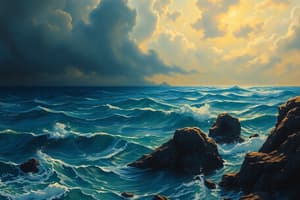Podcast
Questions and Answers
What is the average salinity of ocean water?
What is the average salinity of ocean water?
- 3.5% (35 ppt) (correct)
- 4.0% (40 ppt)
- 2.5% (25 ppt)
- 3.0% (30 ppt)
What is the primary driver of tidal cycles?
What is the primary driver of tidal cycles?
- Coastal geometry and ocean depth
- Sun's gravitational pull
- Wind and atmospheric pressure
- Moon's gravitational pull (correct)
What happens to ocean water as it warms?
What happens to ocean water as it warms?
- It becomes more dense
- Its salinity increases
- It becomes less dense (correct)
- Its pH decreases
What type of tide has two high and two low tides per day?
What type of tide has two high and two low tides per day?
What is the range of ocean water density?
What is the range of ocean water density?
What occurs during spring tides?
What occurs during spring tides?
What is the effect of freshwater input on ocean salinity?
What is the effect of freshwater input on ocean salinity?
What is the average pH of ocean water?
What is the average pH of ocean water?
Flashcards are hidden until you start studying
Study Notes
Ocean Properties
Temperature
- Ocean temperature ranges from -1.8°C to 30°C (average: 17°C)
- Temperature affects density, with warmer water being less dense
- Thermal expansion: warmer water expands, contributing to sea level rise
Salinity
- Average salinity: 3.5% (35 ppt)
- Salinity affects density, with saltier water being denser
- Freshwater input (e.g., river runoff) dilutes salinity
Density
- Ocean water density ranges from 1.02 to 1.03 g/cm³
- Density affects ocean circulation and marine life habitats
Acidity
- Ocean pH ranges from 7.9 to 8.3 (average: 8.1)
- Ocean acidification: decrease in pH due to increased CO₂ absorption
Tides
Definition
- Periodic rise and fall of sea level caused by gravitational interactions between Earth, Moon, and Sun
Types of Tides
- Diurnal tide: one high and one low tide per day
- Semi-diurnal tide: two high and two low tides per day (most common)
- Mixed tide: combination of diurnal and semi-diurnal patterns
Tidal Cycles
- Tidal day: 24 hours and 50 minutes (Moon's rotation period)
- Spring tides: highest high tide and lowest low tide (occur during new moon and full moon)
- Neap tides: lowest high tide and highest low tide (occur during quarter moon)
Factors Affecting Tides
- Moon's gravitational pull: primary driver of tidal cycles
- Sun's gravitational pull: secondary driver, enhances or cancels Moon's effect
- Wind and atmospheric pressure: modify tidal patterns
- Coastal geometry and ocean depth: influence local tidal patterns
Ocean Properties
Temperature
- Ocean temperature ranges from -1.8°C to 30°C, with an average of 17°C
- Warmer water is less dense due to temperature affecting density
- Thermal expansion causes warmer water to expand, contributing to sea level rise
Salinity
- Average salinity is 3.5% (35 ppt)
- Salinity affects density, making saltier water denser
- Freshwater input, such as river runoff, dilutes salinity levels
Density
- Ocean water density ranges from 1.02 to 1.03 g/cm³
- Density affects ocean circulation and marine life habitats
Acidity
- Ocean pH ranges from 7.9 to 8.3, with an average of 8.1
- Ocean acidification occurs due to increased CO₂ absorption, decreasing pH levels
Tides
Definition
- Tides are periodic rises and falls of sea level caused by gravitational interactions between Earth, Moon, and Sun
Types of Tides
- Diurnal tides have one high and one low tide per day
- Semi-diurnal tides have two high and two low tides per day (most common type)
- Mixed tides are a combination of diurnal and semi-diurnal patterns
Tidal Cycles
- A tidal day is 24 hours and 50 minutes, equivalent to the Moon's rotation period
- Spring tides have the highest high tide and lowest low tide, occurring during new moon and full moon
- Neap tides have the lowest high tide and highest low tide, occurring during quarter moon
Factors Affecting Tides
- The Moon's gravitational pull is the primary driver of tidal cycles
- The Sun's gravitational pull is a secondary driver, enhancing or canceling the Moon's effect
- Wind and atmospheric pressure modify tidal patterns
- Coastal geometry and ocean depth influence local tidal patterns
Studying That Suits You
Use AI to generate personalized quizzes and flashcards to suit your learning preferences.



